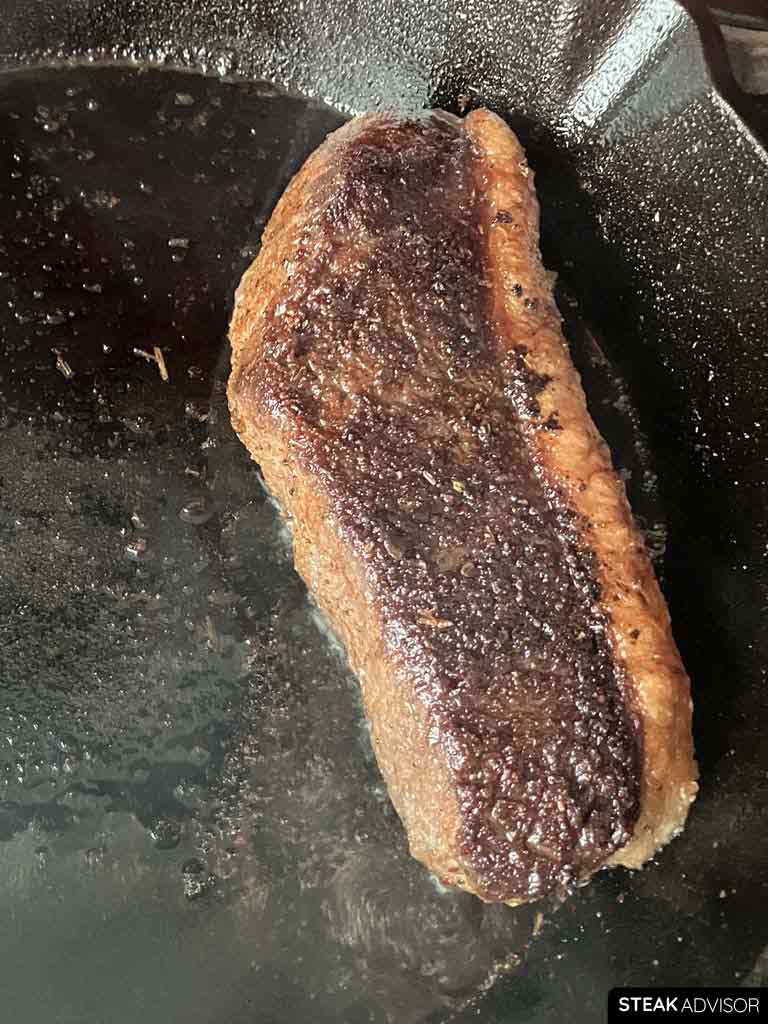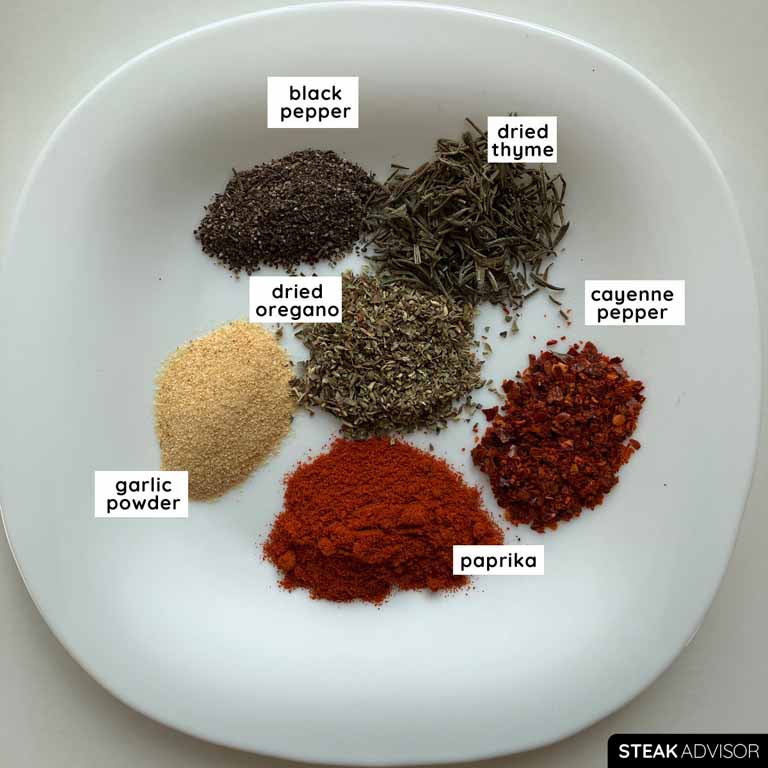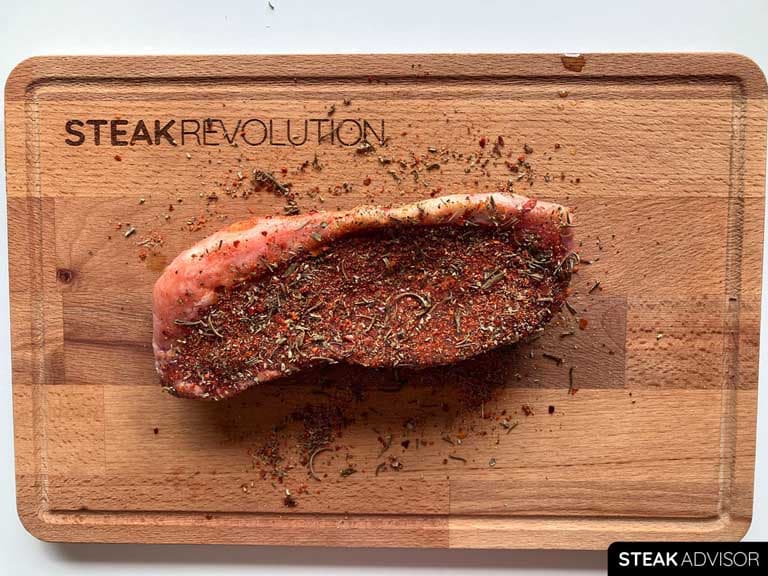| PREP TIME | REST TIME | COOK TIME | TOTAL TIME |
| 15 mins | 45 mins | 10 mins | 1 hour 10 mins |
Try my easy recipe for a blackened steak that’s perfectly seared in a hot cast-iron pan so the outside gets a rich, dark crust while the inside stays perfectly medium rare. The seasoning forms a dark, almost black crust that might look burned, but it’s not; it’s full of flavor. And just before serving, a pour of the leftover buttery pan juices takes every bite to the next level – a simple step that makes it even richer and more complex in flavor.
In this recipe, I’m using a homemade blackening seasoning blend, though you can easily go with a ready-made one from the store. Making it yourself lets you control the flavor, experiment with spices, and create a blend that’s exactly to your taste.
What Does “Blackened” Mean?
“Blackened” is a cooking term that refers to a method where steak, or other meats and fish, are coated in spices and herbs (blackening seasoning) and then seared in a super-hot skillet, usually cast iron. The high heat quickly forms a dark, flavorful crust on the meat’s surface, which is why it’s called “blackened.”
This technique does more than just make the meat look good; it creates a delicious, crispy crust packed with flavor, making every bite a delightful mix of tastes and textures.

The Ingredients You’ll Need
For the steak:
- Steak – about 1.25 to 1.5 inches (3.2–3.8 cm) thick
- 1 teaspoon kosher salt
- 1 tablespoon refined avocado oil (or any other high-smoke point oil or fat)
- 2 tablespoons unsalted butter (about 28 g)
Ingredients to make blackened seasoning:
- 1 tablespoon paprika
- 1 teaspoon garlic powder
- 1 teaspoon ground black pepper
- 1⁄2 tablespoon dried thyme
- 1⁄2 tablespoon dried oregano
- 1⁄2 teaspoon cayenne pepper
Note
For this recipe, I went with picanha, but any thicker steak you love will be great; ribeye, strip steak (new york strip), tenderloin steak (filet mignon), and porterhouse are all great choices. The key is thickness. Go for a steak between 1.25 and 1.5 inches (3.2–3.8 cm) thick for best results. Anything thicker will need extra time over the heat, which can cause the seasoning to burn before the inside reaches the right doneness. On the other hand, a steak thinner than 1 inch (2.5 cm) cooks too quickly, making it difficult to form a proper crust while keeping the inside medium-rare.
How to Cook a Blackened Steak – Step by Step Photos

Start by gathering your ingredients and tools, then follow the steps below. I’ve included extra tips along the way to help you nail the perfect, dark crust and hit the perfect medium-rare every time.
Step 1: Pat Dry and Salt the Steak
Take the steak out of the fridge and pat it dry thoroughly on both sides with paper towels. Season generously with kosher salt, then place it on a wire rack to allow air to circulate around it. Let it rest at room temperature for at least 45–60 minutes. For a deeper flavor, leave it on the rack in the fridge for 4–6 hours with a tray underneath to catch any drips.
While the steak rests, move on to Step 2 and prepare the blackening seasoning.
Note
Salt needs time to work, much longer than just a few minutes, to penetrate the meat and start drying its surface. In this recipe, the focus is on boosting flavor instead of achieving a completely dry exterior through dry-brining. Since the blackening seasoning forms the crust, the surface doesn’t need to be ultra-dry. That’s why I suggest salting the steak for at least 45–60 minutes to notice a difference, or go for 4–6 hours if you want a deeper flavor.
Step 2: Prepare the Blackening Seasoning
In a small bowl, combine the paprika, ground black pepper, dried thyme, dried oregano, cayenne pepper, and garlic powder. Mix well until the spices are evenly blended, then move on to the next step below.
Note
It’s a basic blackened steak seasoning recipe made with common spices most of us already keep at home. Of course, you can easily modify it to your taste by adding extras like onion powder, white pepper, smoked paprika, ground cumin, mustard powder, or even a bit of brown sugar.

Step 3: Apply the Blackening Seasoning
Once the salted steak has rested for at least 45 minutes, pat it dry once more. Cover both sides and the edges with a generous layer of blackening seasoning, pressing gently so it sticks well.


Step 4: Preheat the Cast-Iron Pan
Place a cast-iron skillet over medium-high heat and let it warm for 2–3 minutes. Add one tablespoon of refined avocado oil and heat for another minute. Once the pan is very hot, you’re ready to cook – more on that in the next step.
Note
To get that rich, black crust, the steak needs to hit a very hot surface. Aim for a pan temperature of at least 400°F (204°C) for the best results. That’s why using the right pan and a high–smoke point oil is so important. Use a high–smoke point oil and a heavy, heat-retaining pan. A cast-iron skillet is ideal, but carbon steel or a heavy-bottomed stainless steel pan will also work. As for oil or fat, refined avocado oil is my go-to, though I’ve listed a few other high–smoke point options below that work just as well.
| Type of Fat | Smoke Point ºF | Smoke Point ºC |
|---|---|---|
| Refined Avocado Oil | 520ºF | 270ºC |
| Refined Safflower Oil | 510ºF | 266ºC |
| Beef Tallow | 480ºF | 250ºC |
| Pecan Oil | 470ºF | 243ºC |
| Refined Peanut Oil | 450ºF | 232°C |

Step 5: Cook the Steak
Once the skillet reaches at least 400°F (204°C), carefully place the steak in the pan. Flip it every 45–60 seconds for even cooking until the internal temperature reaches 90°F (32°C). Then, reduce the heat to medium-low, add the butter, and move on to the basting in the next step.
Be gentle when flipping the steak. Sharp-edged tongs can scrape off the blackened seasoning, so use tongs with smooth edges or flip the steak carefully, with a light touch to keep the crust intact.
Note
Use a meat thermometer to monitor the steak’s internal temperature. It’s the easiest and most reliable way to cook a steak to perfect doneness every time, with no guessing involved.
As soon as you add the butter, turn the heat to medium-low. Butter’s low smoke point means it can burn fast, and burnt butter will leave a bitter taste that will ruin the flavor of the steak.

Step 6: Baste the Steak with Butter
Let the butter melt completely. Meanwhile, give the steak’s edges a quick sear, about 30 seconds per side. Once the butter has melted, return your focus to cooking the steak. Keep flipping it every 30 seconds, basting with the melted butter in between flips. If you prefer, you can skip the spoon-basting and place the steak directly in the melted butter for a similar effect.
Remove the steak from the pan when it’s about 20°F (11°C) below your target final temperature. Turn off the heat, then place the steak on a cutting board or wire rack to rest.
Note
Why take the steak off early? It’s all about carryover cooking. Even after it’s out of the pan, the steak’s internal temperature keeps rising, usually by 15 to 30°F (8 to 17°C), depending on several factors. For a steak about 1.25 to 1.5 inches (3.2–3.8 cm) thick, seared over high heat, I’ve found it’s usually about 20°F (11°C) in the first 6–7 minutes of resting. This step helps prevent overcooking and ensures your steak comes out just right. Taking a thick, pan-seared steak off the heat only 5–10°F (3–6°C) below target is a common mistake that usually results in overdone meat.

Step 7: Let the Blackened Steak Rest
After cooking, let the steak rest for 6–7 minutes before slicing. As it rests, it will continue cooking from residual heat, raising the internal temperature by about 20°F (11°C) and reaching your target doneness.
When it’s time to slice that delicious blackened steak, here’s a quick tip: cuts like picanha (coulotte), skirt, flank, or hanger always slice against the grain to shorten the muscle fibers and keep every bite easier to chew and more tender. Naturally tender cuts like ribeye or filet mignon (tenderloin steak), you can slice them however you like. And instead of letting those buttery pan juices go to waste, pour them over sliced steak or a side dish like mashed potatoes or roasted veggies for an extra flavor boost.
Note
After taking the steak off the pan, it’s a good idea to monitor the steak’s internal temperature. I recommend using a wireless thermometer for that. If it gets close to your target doneness within the first 1–3 minutes of resting, don’t wait and slice it right away to stop the carryover cooking process. And if you’ve already overcooked it a little in the pan, slicing immediately will help keep it from going even further past your desired doneness.

FAQs
What to serve with blackened steak?
Blackened steak pairs well with a variety of sides, from potatoes to fresh, crisp vegetables. Here are a few ideas to inspire you:
- Oven-Roasted Potatoes
- Steak Frites
- Broccoli Salad
- Baked Potato Wedges
- Sautéed Asparagus
What are the best steaks for a blackened steak recipe?
This recipe works best with steaks that are naturally tender and around 1.25 to 1.5 inches (3.2–3.8 cm) thick. You can use thinner cuts, but it’s nearly impossible to get that deep blackened crust without overcooking the inside. On the other hand, very thick cuts, like 2.25 inches (5.7 cm) or more, take a lot longer to cook through, which can risk burning the seasoning and ruining the flavor.
Here are the cuts I’ve found work best for my blackened steak recipe (all thick, tender, and full of flavor):
- Ribeye Steak,
- Strip Steak (New York Strip),
- Filet Mignon (Tenderloin Steak),
- Picanha Steak (Coulotte Steak),
- Tomahawk Steak,
- Cowboy Steak,
- Denver Steak,
- Flat Iron Steak (only the thicker ones),
- Top Blade Steak,
- Baseball Steak (Top Sirloin Filet).

Blackened Steak Recipe
- Prep Time: 15 minutes
- Rest Time: 45 minutes
- Cook Time: 10 minutes
- Total Time: 1 hour 10 minutes
Description
Easy blackened steak made with a simple homemade spice blend that delivers a bold flavor and a crispy, blackened crust.
Ingredients
For the steak:
- Steak – about 1.25 to 1.5 inches (3.2–3.8 cm) thick
- 1 teaspoon kosher salt
- 1 tablespoon refined avocado oil (or any other high-smoke point oil or fat)
- 2 tablespoons unsalted butter (about 28 g)
Ingredients to make blackened seasoning:
- 1 tablespoon paprika
- 1 teaspoon garlic powder
- 1 teaspoon ground black pepper
- 1⁄2 tablespoon dried thyme
- 1⁄2 tablespoon dried oregano
- 1⁄2 teaspoon cayenne pepper
Instructions
- Pat Dry and Salt the Steak: Take the steak out of the fridge and pat it dry thoroughly on both sides with paper towels. Season generously with kosher salt, then place it on a wire rack to allow air to circulate around it. Let it rest at room temperature for at least 45–60 minutes. For a deeper flavor, leave it on the rack in the fridge for 4–6 hours with a tray underneath to catch any drips. While the steak rests, move on to Step 2 and prepare the blackening seasoning.
- Prepare the Blackening Seasoning: In a small bowl, combine the paprika, ground black pepper, dried thyme, dried oregano, cayenne pepper, and garlic powder. Mix well until the spices are evenly blended, then move on to the next step below.
- Apply the Blackening Seasoning: Once the salted steak has rested for at least 45 minutes, pat it dry once more. Cover both sides and the edges with a generous layer of blackening seasoning, pressing gently so it sticks well.
- Preheat the Cast-Iron Pan: Place a cast-iron skillet over medium-high heat and let it warm for 2–3 minutes. Add one tablespoon of refined avocado oil and heat for another minute. Once the pan is very hot, you’re ready to cook – more on that in the next step.
- Cook the Steak: Once the skillet reaches at least 400°F (204°C), carefully place the steak in the pan. Flip it every 45–60 seconds for even cooking until the internal temperature reaches 90°F (32°C). Then, reduce the heat to medium-low, add the butter, and move on to the basting in the next step. Be gentle when flipping the steak. Sharp-edged tongs can scrape off the blackened seasoning, so use tongs with smooth edges or flip the steak carefully, with a light touch to keep the crust intact.
- Baste the Steak with Butter: Let the butter melt completely. Meanwhile, give the steak’s edges a quick sear, about 30 seconds per side. Once the butter has melted, return your focus to cooking the steak. Keep flipping it every 30 seconds, basting with the melted butter in between flips. If you prefer, you can skip the spoon-basting and place the steak directly in the melted butter for a similar effect. Remove the steak from the pan when it’s about 20°F (11°C) below your target final temperature. Turn off the heat, then place it on a cutting board or wire rack to rest.
- Let the Blackened Steak Rest: After cooking, let the steak rest for 6–7 minutes before slicing. As it rests, it will continue cooking from residual heat, raising the internal temperature by about 20°F (11°C) and reaching your target doneness.
- Serve the Pan-Seared Blackened Steak: When it’s time to slice that delicious blackened steak, here’s a quick tip: cuts like picanha (coulotte), skirt, flank, or hanger always slice against the grain to shorten the muscle fibers and keep every bite easier to chew and more tender. Naturally tender cuts like ribeye or filet mignon (tenderloin steak), you can slice them however you like. And instead of letting those buttery pan juices go to waste, pour them over sliced steak or a side dish like mashed potatoes or roasted veggies for an extra flavor boost.
